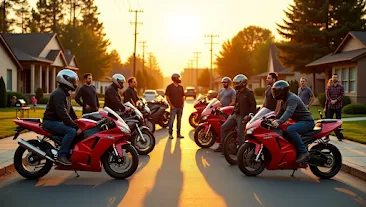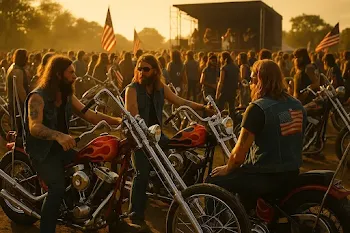Biker Culture Evolved Through History
For centuries, the image of the rider whether on horseback or a custom chopper has stood as a symbol of freedom, rebellion, and adventure. Today’s motorcycle enthusiasts belong to a vibrant subculture rooted in centuries of tradition. In this post, we explore the history of bikers and riders, tracing their journey from ancient times to the electric, tech-savvy riders of 2025.
If you've ever wondered how biker culture started or want to discover the top motorcycle movements throughout history, this is your ultimate guide.
The Origins of Riding Culture
Before motorcycles roared across highways, riding was done on horseback. The first riders in history were warriors, messengers, and nomads who relied on horses for survival, warfare, and transportation.
Though separated by millennia from bikers, these early riders laid the foundation for a culture centered around mobility, brotherhood, and resilience.
The Birth of Biker Culture 1885–1910
The modern history of bikers began in the late 19th century. In 1885, Gottlieb Daimler and Wilhelm Maybach created the first internal combustion motorcycle, known as the "Reitwagen." It wasn’t long before motorcycles became more practical and accessible.
Riding clubs began to form around shared interests in adventure and mechanics, laying the groundwork for today’s biker communities.
The Rise of Outlaw Biker Culture 1940s–1960s
After World War II, many returning soldiers turned to motorcycles to rediscover the adrenaline and camaraderie they missed from combat. This era saw the birth of outlaw biker culture a rebellious response to mainstream society.
Events like the Hollister Riot of 1947 and Hollywood films like The Wild One fueled public fascination. The idea of the "biker outlaw" became etched in pop culture.
This period also saw the formation of top motorcycle clubs like:
Hells Angels Motorcycle Club
Bandidos
Outlaws MC
Mongols MC
These groups were often misunderstood, but they were bound by deep loyalty, a strict code of honor, and a love for the road. The culture was defined by how bikers lived, dressed, and rode setting the tone for decades to come.
The Era of Customization 1970s–1980s
The 1970s and 1980s marked a golden age for motorcycle enthusiasts who wanted more than just a factory bike. This era gave rise to the custom motorcycle movement, where riders modified their bikes into choppers, bobbers, and café racers each with its own identity.
Biker rallies like the Sturgis Motorcycle Rally (established in 1938) and Daytona Bike Week exploded in popularity, becoming top events for bikers across the globe.
The culture also bled into fashion and music. Leather jackets, denim, and patches became staples of the biker identity, while rock anthems like Born to Be Wild solidified the image of the free-spirited rider.
How Modern Riders Changed the Game 1990s–2000s
As motorcycle technology improved and global access increased, the biker community began to evolve. Modern riders no longer fit one mold. The 1990s introduced a new breed of motorcyclists: weekend warriors, commuters, women riders, and even executives.
.jpg)
Sportbikes from Honda, Yamaha, and Kawasaki became popular, shifting the focus from rugged rebellion to performance and speed. Motorcycle safety also became a priority, with helmet laws, riding schools, and safety gear being widely promoted.
Online communities and biker forums allowed riders to connect, organize events, and share experiences, breaking geographic barriers. The digital age began changing how bikers interact and evolve.
Bikers in the 21st Century 2010–2025
In the last 15 years, rider culture has become more inclusive, technological, and socially aware. The biker scene has expanded beyond stereotypes and embraced diverse communities:
Women riders are growing rapidly, with global communities like The Litas and Babes Ride Out.
Black biker events like Black Bike Week celebrate identity and unity within the riding world.
Innovation has also reshaped the industry. Electric motorcycles like the Harley-Davidson LiveWire and Zero Motorcycles are pushing boundaries on sustainability. Smart helmets, mobile apps, and built-in navigation systems have transformed how modern bikers ride.
Social media has become a key part of biker culture. Riders now share cross-country trips on Instagram, document club life on YouTube, and host virtual rallies in the metaverse. Today’s biker is as likely to be an influencer as a mechanic.
The Future of Riding Culture
As we look beyond 2025, the future of biking will be defined by a balance between tradition and innovation. Here’s how biker culture is likely to evolve:
Sustainability will become central as electric bikes and carbon-conscious manufacturing grow.
Tech integration like AI-powered safety systems and virtual dashboards will enhance both performance and protection.Cultural preservation through documentaries, books, and virtual museums will help newer generations understand the history of riders and bikers.
Yet despite the tech and trends, one thing stays true: the spirit of the ride endures.
Why Biker Culture Still Matters
The top reason people become bikers hasn’t changed it’s all about freedom. From warriors on horseback to electric-bike commuters in smart gear, the soul of riding is about experiencing life on your terms.
So next time you feel the urge to hit the road, know that you're riding with the ghosts of horsemen, war heroes, and rebels who came before you.









.jpg)


0 Comments